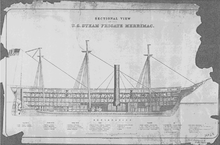That is some code homeboy......
Merrimack was launched by the Boston Navy Yard
15 June 1855; sponsored by Miss Mary E. Simmons; and commissioned 20
February 1856, Captain Garrett J. Pendergrast in command. She was the
second ship of the Navy to be named for the Merrimack River.
Shakedown cruises took the new screw frigate to the Caribbean and to Western Europe. Merrimack visited Southampton, Brest, Lisbon, and Toulon before returning to Boston and decommissioning 22 April 1857 for repairs. Recommissioning 1 September 1857, Merrimack got underway from Boston Harbor 17 October as flagship for the Pacific Squadron. She rounded Cape Horn and cruised the Pacific coast of South and Central America until heading for home 14 November 1859. Upon returning to Norfolk, she decommissioned 16 February 1860.
Merrimack was still in ordinary during the crisis preceding Lincoln's inauguration. Soon after becoming Secretary of the Navy, Gideon Welles took action to prepare the frigate for sea, planning to move her to Philadelphia. The day before the firing on Fort Sumter, Welles directed that "great vigilance be exercised in guarding and protecting" Norfolk Navy Yard and her ships. On the afternoon of 17 April 1861, the day Virginia seceded, Engineer in Chief B. F. Isherwood managed to get the frigate's engines lit off; but the previous night secessionists had sunk light boats in the channel between Craney Island and Sewell's Point, blocking Merrimack. On the 20 April, before evacuating the Navy Yard, the U.S. Navy burned Merrimack to the waterline and sank her to preclude capture.
The Confederacy, in desperate need of ships, raised Merrimack and rebuilt her as an ironclad ram, according to a design prepared by Lt. John Mercer Brooke, CSN. Commissioned as CSS Virginia 17 February 1862, the ironclad was the hope of the Confederacy to des
History
USS Merrimack sectional view
Shakedown cruises took the new screw frigate to the Caribbean and to Western Europe. Merrimack visited Southampton, Brest, Lisbon, and Toulon before returning to Boston and decommissioning 22 April 1857 for repairs. Recommissioning 1 September 1857, Merrimack got underway from Boston Harbor 17 October as flagship for the Pacific Squadron. She rounded Cape Horn and cruised the Pacific coast of South and Central America until heading for home 14 November 1859. Upon returning to Norfolk, she decommissioned 16 February 1860.
Merrimack was still in ordinary during the crisis preceding Lincoln's inauguration. Soon after becoming Secretary of the Navy, Gideon Welles took action to prepare the frigate for sea, planning to move her to Philadelphia. The day before the firing on Fort Sumter, Welles directed that "great vigilance be exercised in guarding and protecting" Norfolk Navy Yard and her ships. On the afternoon of 17 April 1861, the day Virginia seceded, Engineer in Chief B. F. Isherwood managed to get the frigate's engines lit off; but the previous night secessionists had sunk light boats in the channel between Craney Island and Sewell's Point, blocking Merrimack. On the 20 April, before evacuating the Navy Yard, the U.S. Navy burned Merrimack to the waterline and sank her to preclude capture.
USS Merrimack aflame during the burning of the Norfolk Navy Yard, 20 April 1861


Comments
Post a Comment